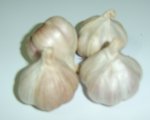Weeds
Grasses
Sedges
Broadleaf
Diseases
Fungal
Bacterial
Viral
Agro-ecology
Soil analysis is highly recommended to determine fertility and pH levels before planting garlic. The ideal soil pH ranges from 6.0 - 7.5. Soil sampling determines garlic’s nutrient requirements. High yield is only attained when fertilizer used is related to the fertility level of the soil and other of nutrients in manure, crop residues, and other organic sources.
Soil preparation is done 3-4 weeks before planting. Plow-under farm manure or compost materials into the soil. The organic matters increase the manageability of the soil and improve its moisture and nutrient holding capacities. Soil with sufficient organic matter is less prone to crusting and compaction.
Proper seed selection is a must. Plant only pest-free bulbs and cloves. Seeds with fungi can transmit white rot, stalk and basal rot, and leaf blight. Seed infected with bacteria
can transmit mold rot.
Practice
crop rotation when planting garlic. Do not plant garlic where onions or a member of the Allium family has been previously grown. Garlic grows best on raised beds alternated with furrows mulched with rice straw (CABI, 2000).
Planting basil and marigold along the borders of garlic helps reduce thrips infestation (MMSU, 2003).
Lagundi leaves (
Vitex negundo) when incorporated into the rice straw mulch help control root rot disease of garlic. Neem leaves when incorporated into the rice straw mulch helps control tangle top (MMSU, 2003).
External links
References
- CABI. (2000): Crop protection compendium. Global module, 2nd edition. CABI Publishing, Wallingford, UK.
- CABI. (2004): Crop protection compendium. 2004 Edition. CAB International Publishing. Wallingford, UK.
- MMSU. (2003): 7 new botanical extracts vs. garlic pests. Mariano Marcos State University. Batac, Ilocos Norte, Philippines.

